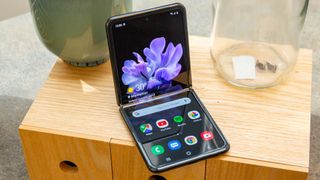New Samsung Galaxy Z Flip could get 5G — with one major catch
But will anyone care about a 5G foldable?

The Samsung Galaxy Z Flip may not be perfect, but it's the most exciting phone we've seen from the company in a while.
The Z Flip was the first folding smartphone to be relatively attainable and decently built, and its clamshell form factor has made it remarkably compact and easy to live with. Now it appears Samsung might be preparing a 5G model.
This news comes to us from SamMobile, which has it on good authority that Samsung is preparing a 5G variant of its clamshell foldable for release later this year. The report doesn't get any more specific than that, though it has us wondering how Samsung will even pull off such a feat from a packaging standpoint.
- The best Android phones to buy today
- The best small phones that'll easily fit in your pocket
- New: Galaxy S20 too expensive? This Samsung 5G phone will be cheaper
Consider this: The 6.4-inch Samsung Galaxy S20 does support 5G, though it lacks connectivity to the millimeter-wave (mmWave) networks that deliver the fastest speeds across the shortest distances.
The reason is the S20's size. While Samsung was able to fit the larger Plus and Ultra variants with mmWave running gear, it didn't have space for those components in the smallest model. Therefore, the base Galaxy S20 can only connect to sub-6GHz networks, which has speeds akin to the 4G LTE we enjoy today.
If Samsung were to build a 5G-compatible Z Flip that was precisely the same size as the original, it would be hard to imagine that the revamped foldable could support mmWave tech.
Additionally, there's the problem of battery life. The Z Flip has a 3,300-mAh battery, which isn't too shabby. However, mmWave draws a lot of power and without beefing up capacity, it's likely the phone's longevity on a charge would seriously suffer.
Sign up to get the BEST of Tom’s Guide direct to your inbox.
Upgrade your life with a daily dose of the biggest tech news, lifestyle hacks and our curated analysis. Be the first to know about cutting-edge gadgets and the hottest deals.

In short, while Samsung certainly could build a 5G-compatible Galaxy Z Flip, we're not entirely sure why it would make the effort right now.
If the company is forced to leave out the mmWave part, the effort almost wouldn't be worth it — sub-6GHz speeds aren't noticeably faster than LTE, after all. And if Samsung did stuff those components into the phone, it would probably have to make the phone's battery and overall design significantly larger, taking away the Z Flip's primary appeal as a compact foldable.
Either way, a 5G Z Flip would certainly be more expensive than the $1,380 price of the existing model.
There's also the long-rumored Samsung Galaxy Fold 2 to consider — it's a more fitting successor to the original Samsung Galaxy Fold that employs tablet-like proportions and folds horizontally rather than vertically. That device is certainly coming nearer to the end of 2020, perhaps around the same time as the Samsung Galaxy Note 20.
In case you chalked up foldables as a passing fad, make no mistake — all rumors suggest Samsung is more committed to folding phones than ever, and the new form factor is not going away anytime soon.
Adam Ismail is a staff writer at Jalopnik and previously worked on Tom's Guide covering smartphones, car tech and gaming. His love for all things mobile began with the original Motorola Droid; since then he’s owned a variety of Android and iOS-powered handsets, refusing to stay loyal to one platform. His work has also appeared on Digital Trends and GTPlanet. When he’s not fiddling with the latest devices, he’s at an indie pop show, recording a podcast or playing Sega Dreamcast.
